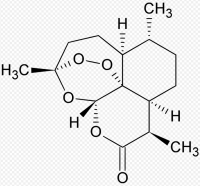








Artemisinin, and its derivatives are a group of drugs that possess the most rapid action of all current drugs against Plasmodium falciparum malaria. Treatments containing an artemisinin derivative (artemisinin-combination therapies, ACTs) are now standard treatment worldwide for P. falciparum malaria. Artemisinin is isolated from the plant Artemisia annua, sweet wormwood, an herb employed in Chinese traditional medicine. It can now also be produced using genetically engineered yeast.
Besides Dr. Arthur L. Horwich and Dr. Franz-Ulrich Hartl, who won the award for basic medical research for their discoveries about protein folding, the foundation is honoring an 81-year-old Chinese scientist for her work on turning an herbal medicine into a widely used antimalarial drug.
The scientist is Dr. Tu Youyou, and the antimalarial drug is artemisinin, which was discovered decades ago.
Dr. Tu and her colleagues began their work in the 1960s, during the Cultural Revolution, when the Chinese government began a project to find a new malaria drug that could replace the standard treatment, chloroquine, which was losing effectiveness as malaria parasites developed resistance.
They scoured the literature on ancient Chinese remedies and collected 380 extracts from 200 herbs that offered promise. One of the plants they studied was sweet wormwood, or Artemisia annua, which was used by Chinese herbalists centuries ago to treat fever.
Dr. Tu and her team discovered a way to extract an active substance from the plant, removed a toxic portion of it, and demonstrated that it wiped out the malaria-causing parasite in animals. The resulting drug, artemisinin, was later shown to cure malaria in humans.
Today, artemisinin and its derivatives are typically coupled with other treatments to combat malaria, and the World Health Organization recommends this combination therapy as the “first-line treatment” against the disease.